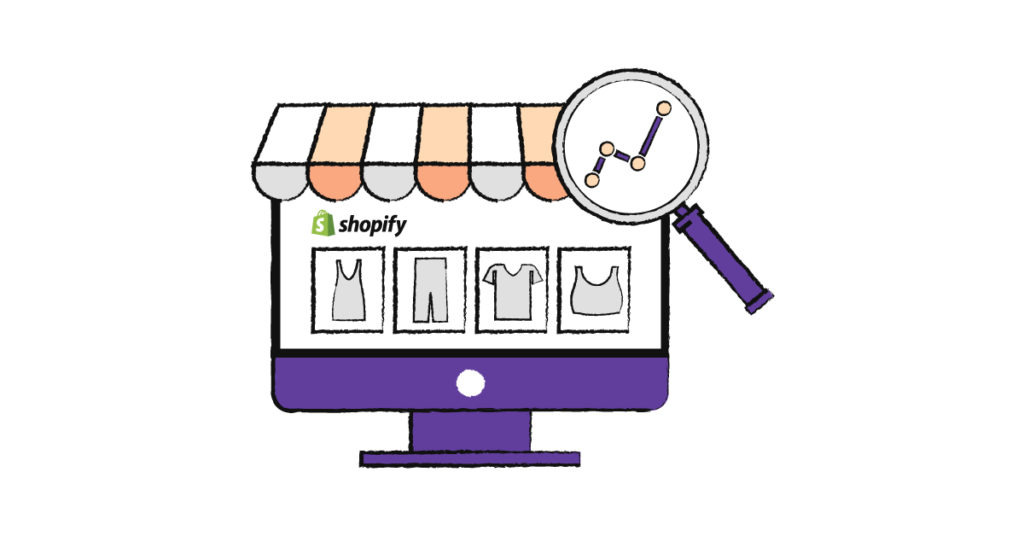Your Shopify store is all set up, and you’re ready to make some sales. The only problem? No one is visiting your store, so you’re not getting any business.
You may have incredible products and a beautifully designed website, but none of this matters if customers can’t find your store.
Sixty-eight percent of online experiences start on a search engine, and nearly half of online shoppers begin their purchasing journeys on search engines. So if you haven’t made search engine optimization a priority, you’re missing out on potential customers because they don’t even know your ecommerce store exists.
However, with this guide to Shopify SEO, you can take steps to optimize your website for search. That means customers can easily find your Shopify store — and you can start bringing in sales.
1. Optimize your site structure.
A logical site structure helps both shoppers and search engines easily navigate your website. Google also appreciates well-mapped sites and rewards them by ranking them higher in search results.
Shopify automatically generates a sitemap for you, but it’s up to you to enter information about your store and its products to create that sitemap.
Hierarchy is important for sitemaps. Shopify will structure your store based on its collections and the products that belong to each collection, as illustrated in the diagram below.
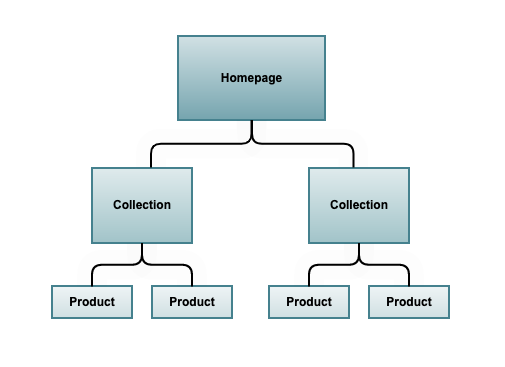
For example, if you sell apparel, one of your collections might be “shirts.” Under this category, you might list products like “T-shirts,” “tank tops,” and “sweatshirts.” Then, there may be subcategories of these products, such as “red T-shirt” and “blue T-shirt.”
It’s easy to create these collection pages and product pages in Shopify. To make a collection, simply log into your Shopify account. From the right-hand menu, go to “Products” and select “Collections.”Then click “Create collection.”

To create a product page on Shopify, navigate to “Products” and select “All products.” Then click “Add product.”

Once you create your product page, be sure to add it to a collection, so your store will be properly structured.

When you’ve finished creating collection and product pages, return to the right-hand menu and select “Online Store” and then “Navigation.” Then add your collections to the main menu of your store.
You can view your store’s sitemap by visiting your store URL followed by /sitemap.xml.
Addressing product level duplication
Per Nick LeRoy, SEO consultant and author of the #SEOForLunch newsletter, one issue “out of the box” with Shopify is that all product URLs tied to multiple collections can be navigated via multiple unique URLs.
- Site.com/collection/tops/green-t-shirt.html
- Site.com/collection/t-shirts/green-t-shirt.html
- Site.com/products/green-t-shirt.html
The default solution that Shopify applies are canonical tags which
transfer any and all SEO value to a single URL variation. However, this
is not the ideal solution.
Nick recommends modifying one file titled “collection-template.liquid”.
In this file, identify the line of code reading “{{ product.url | within:
collection }}”.
By removing the “| within: collection” your Shopify website will link to
the single product URL variant “/products/green-t-shirt.html”.
This solution will not only avoid the duplication of pages but allow for a
more optimized experience for search engines.
Now that your Shopify store is properly structured, submit your sitemap to Google Search Console.
2. Conduct keyword research.
Keyword research is the process of finding words and phrases that people enter into search engines, so you can create search-optimized content around those terms.
A good way to get started with keyword research is to put yourself in your customers’ shoes. What search terms would someone enter to find what you’re selling?
Let’s say you sell hand-knitted wool scarves in your Shopify store. If someone were looking for such an item, they may google a variety of search terms, such as “wool scarf,” “handmade scarves,” or “hand-knitted scarf,” as well as many others.
As you put together a list of potential search terms, also consider how a potential customer might phrase their search as a question, such as “Where can I buy a hand-knitted wool scarf?” In fact, 8% of search queries are phrased as questions.
Once you have an initial list of search terms, you need to determine which keywords to target as part of your Shopify SEO strategy. There is a wealth of keyword tools available that are designed to help you determine which keywords are the best ones to target.
These tools will provide you with a lot of information about your keywords, including their monthly search volume and keyword difficulty. The ideal keyword has a high monthly search volume (MSV) and low keyword difficulty (KD).
For example, we entered the keywords listed above into Ahrefs’ Keywords Explorer tool. The results reveal that all four keywords have an extremely difficulty score, but one of them, “wool scarf,” receives 1,600 searches per month — a much higher search volume than all the others. This tells us that “wool scarf” is a keyword that we should optimize our product pages for. (More on that soon.)
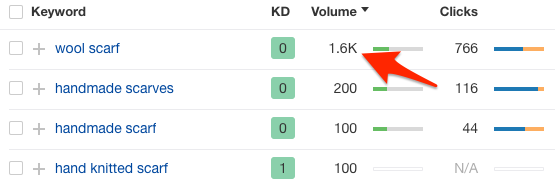
Learn more with Shopify’s guide to keyword research for ecommerce.
3. Optimize URLs, titles, and meta descriptions.
Now that you’ve identified your target keywords, it’s time to use them to optimize your Shopify store for search. Start your Shopify SEO optimization with the pages you want customers to find the most: collections and product pages.
Shopify makes this extremely easy. Simply select the collection or product you want to optimize and scroll to the bottom of the page where you’ll see “Search engine listing preview.” Click “Edit website SEO.”
Now you’ll be able to enter a page title and description, and you can even edit the URL of the page.
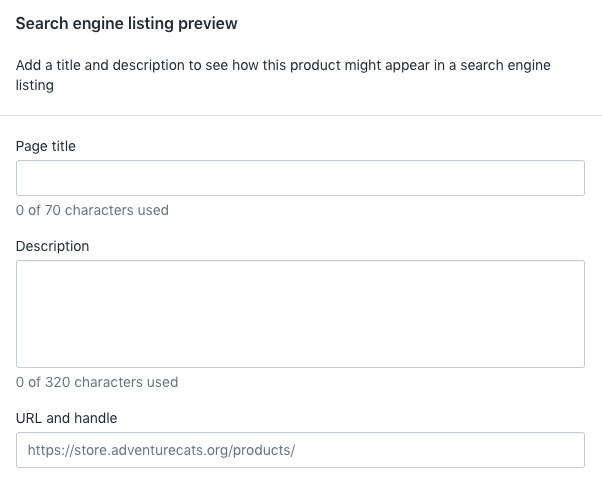
Here are some best practices to keep in mind to optimize your URLs, titles, and meta descriptions for Shopify SEO.
- Write a unique title tag and meta description for every page of your store.
- Include your target keyword. Avoid keyword stuffing or overloading the page with the same keyword.
- Keep your entries to the number of characters that Shopify recommends beneath each section. For example, your page description should be 320 characters or fewer so that the full text displays in search results.
- Make your writing compelling. Just because you’re optimizing a page description for a keyword doesn’t mean the text has to be dull. Write copy that entices a user to click.

4. Write unique product descriptions.
Your product descriptions should tell search engines exactly what you’re selling. But they must also be unique — meaning they’re different from competitors’ descriptions, even if you’re selling the exact same product — and they must compel shoppers to buy.
For example, let’s say you sell a book in your Shopify store that’s also available on Amazon, as well as other ecommerce sites. Instead of using the same product description that you’ll find on Amazon or the publisher’s website, craft your own copy.
Take a look at how the Adventure Cats store has differentiated its product description for a book from the copy that Amazon uses, which is copied verbatim from the book publisher’s website. Taking the time to do this not only allows you to cater the description to your specific audience, but it may also help your store rank higher in search results.
5. Add alt text to images.
Alternative text, or alt text, is the text that describes an image, which helps Google understand an image’s subject matter.
More searches are conducted via Google Images than Amazon, YouTube, and Facebook combined, so adding optimized alt text can be a great source of traffic for your product pages.
Let’s say you’re in the market for a unique item: a wax stamp to seal invitations for a garden party. The Shopify-based store Artisaire specializes in custom wax stamps for all occasions and even has one that it markets specifically for garden parties.
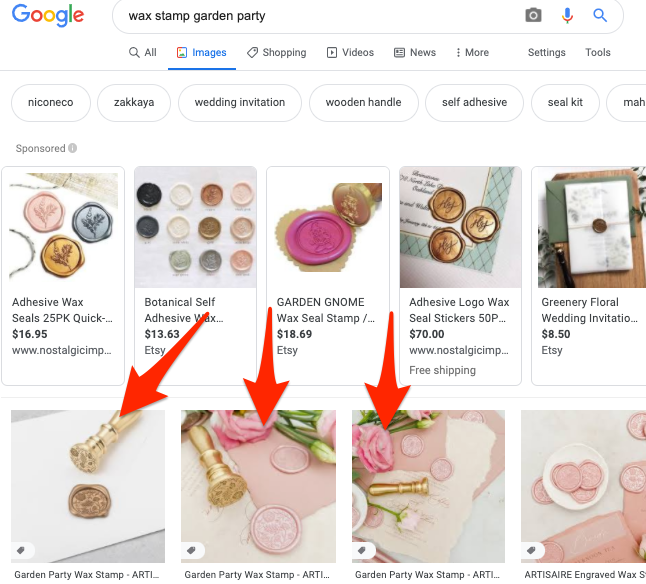
By ensuring that its product images contain detailed product information in the alt text, Artisaire can ensure that its stamp is in the top organic results that Google Images returns for searches like “wax stamp garden party.”
6. Boost site speed.
If you’ve ever waited…and waited…for a web page to load, you know how frustrating it can be. You might have even given up and clicked away. In fact, 40% of Internet users abandon sites that take more than three seconds to load.
Google knows this, which is why it takes site speed into account for search rankings.
You can evaluate page speed with Google’s PageSpeed Insights. If you find that certain pages are taking more than five seconds to load, it’s time to take some steps to bring that number down.
There many ways you can improve the speed of the pages on your site, but the most important for Shopify SEO is image optimization. Your store likely has a lot of imagery that showcases the various products you have for sale. If you’ve uploaded massive image files, it’s no wonder pages take so long to load. Consider installing a Shopify app like Crush.pics to reduce image file sizes.
Another way for Shopify users to shave some time off the load speed is to uninstall any Shopify apps they’re not currently using.
7. Install Shopify SEO apps.
While we’re on the subject of apps, let’s talk about the ones that can help improve your store’s search rankings.
Shopify has thousands of apps available that offer a range of helpful uses, and there are several designed to assist with Shopify SEO. While they can’t help with all aspects of SEO — they’re not going to create search-optimized content for you or help you acquire backlinks — they can help you boost organic traffic.
Let’s take a look at three popular Shopify SEO apps and what they can do for your store.
- Plug in SEO: This app is designed to be a one-stop-shop for all things Shopify SEO. It integrates with Google Search Console and checks your site for SEO-related problems. When it identifies an issue, it walks you step-by-step through how to fix it, and it has a wealth of tutorials to help you learn. Cost: Free plan available, $20/month for full plan
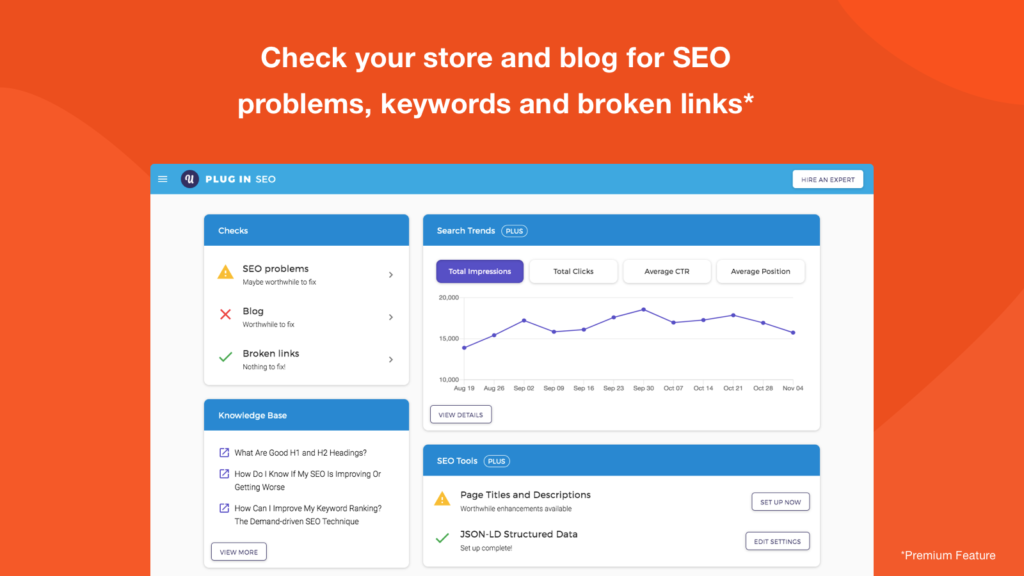
Ultra SEO: This Shopify app allows users to quickly and easily edit meta tags on every page of their store that would otherwise be autofilled with default titles and descriptions. Cost: $10/month
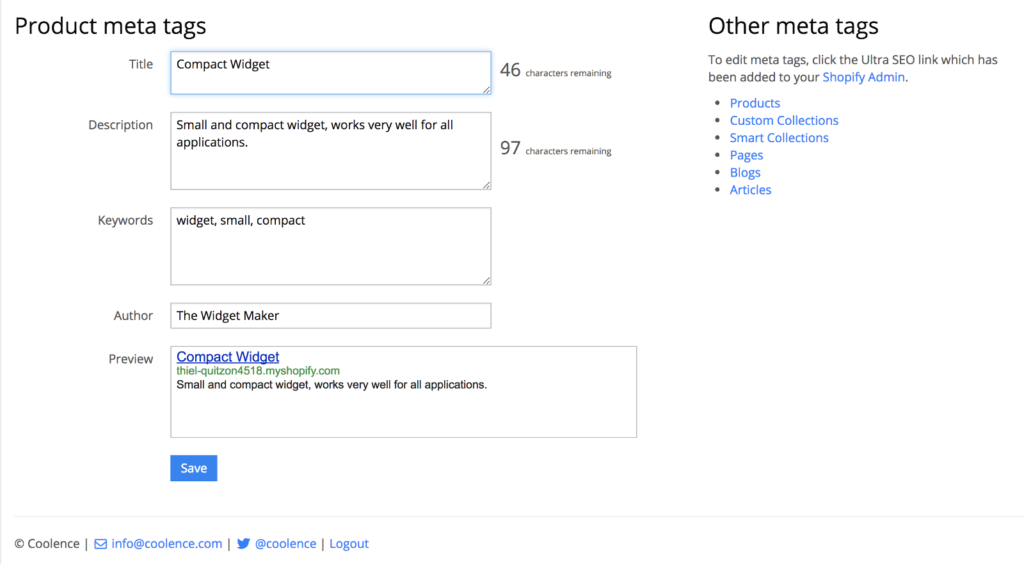
Smart SEO: This app saves you from having to manually enter meta tags and alt tags because it generates them for you. It also allows you to manage your store sitemap and select which pages you want search engines to crawl. Cost: $4.99/month
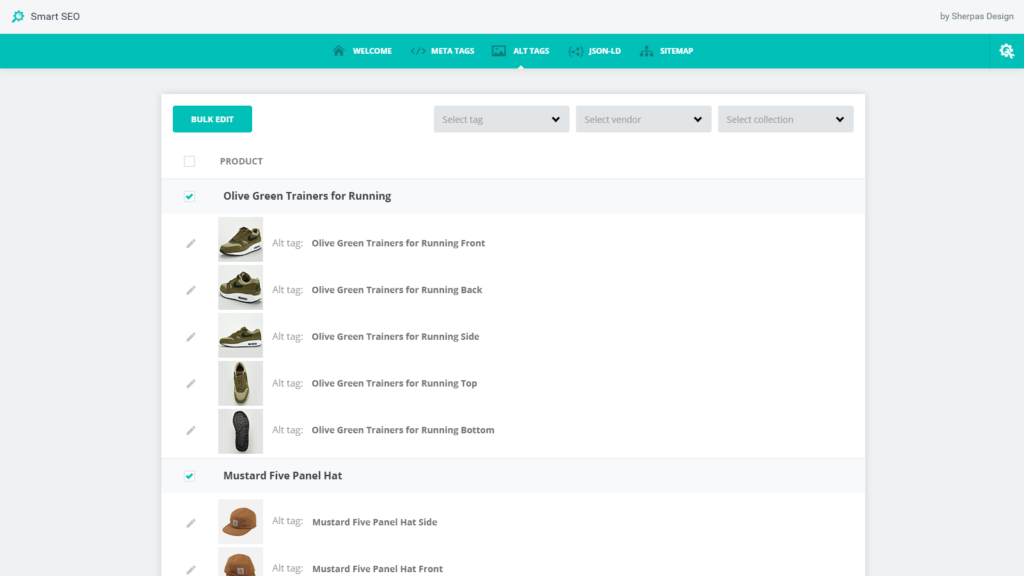
8. Start blogging.
You may think of your Shopify store as simply a store, but adding regular blog content to your site is a great way to improve your Google rankings and attract more people to your ecommerce site.
But creating quality content for your site is about much more than simply gaining traffic. There are several other benefits, as well.
For one, you can reach customers at all stages of the marketing funnel. Let’s take the example of the wax stamps again. If someone is searching the Internet for a specific type of wax stamp, they clearly know what they’re looking for and are likely ready to make a purchase.
The advantage of creating informational blog content, however, is that you can begin to reach potential customers much earlier in their buying journey. For example, you could blog about how to throw a garden party, the history of wax stamps, or even how to make your own wax stamps. This allows you to educate people who may be only vaguely interested in actually purchasing a wax stamp, but now that they’re on your blog, it’s more likely they’ll buy from you in the future.
Publishing blog content on your site also helps you establish yourself as an authority on your particular product. Plus, it provides you with an excellent way to “sell” your products within the posts.
Finally, having more content on your site will help you acquire more backlinks (links to your site from other websites). Backlinks are kind of like a vote of confidence for your website that tells search engines that you publish quality content that others recommend. In fact, Google says that backlinks are one of its top three ranking factors.
Want to learn more about how blog content can help with Shopify SEO? Check out our advanced guide to content marketing for ecommerce to learn more.
Shopify SEO is just the beginning
After completing these eight steps, your Shopify store is well on its way to attracting more organic traffic — as well as sales.
But there’s a lot more you can do with SEO. Learn more about SEO for ecommerce sites with this comprehensive guide from SpyFu.
And if you’re ready to attract new buyers and grow your store even more, check out these 10 ways to market your ecommerce site.

